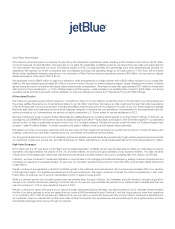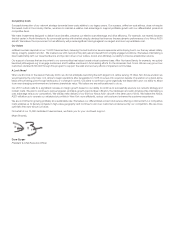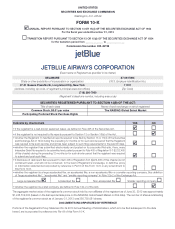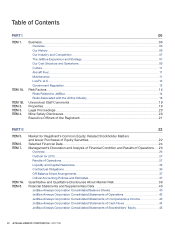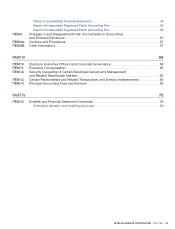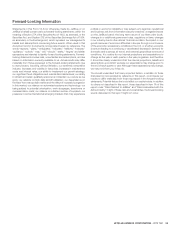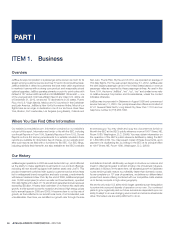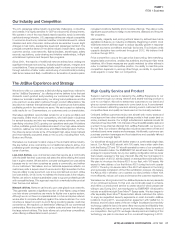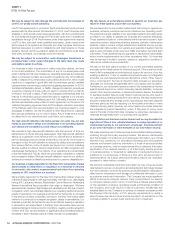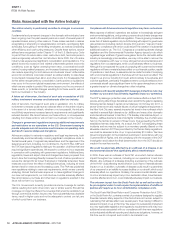JetBlue Airlines 2012 Annual Report Download - page 13
Download and view the complete annual report
Please find page 13 of the 2012 JetBlue Airlines annual report below. You can navigate through the pages in the report by either clicking on the pages listed below, or by using the keyword search tool below to find specific information within the annual report.
JETBLUE AIRWAYS CORPORATION-2012 10K 09
PART I
ITEM 1Business
In considering new markets, we generally focus on either underserved
markets or those with high average fares. As a part of this process, we
analyze publicly available data from the Department of Transportation,
or DOT, showing the historical number of passengers, capacity and
average fares over time. Using this data, combined with our knowledge
and experience about how comparable markets have reacted in the past
to capacity changes, we forecast the expected level of demand that may
result from our introduction of service and lower prices. We also consider
the anticipated response of existing airlines in the particular market. When
deciding upon and entering new markets, we analyze the uniqueness of
each market and design our operations to target the customer base which
will allow us to compete effectively and grow profi tably. For example, in
the Caribbean our operations are primarily targeted on the leisure traveler,
whereas in Boston, we are focused on both the business traveler and
the leisure traveler.
These forecast techniques are designed to portray what we expect the
market to produce upon maturity. We measure maturity of a market based
upon cash break-even and profi tability. We consider, among other things,
the level of investment we believe may be required to reach a steady
state of performance in a given market. Each route analysis is unique for
many reasons including, but not limited to, geography, demographics,
competitive dynamics and our existing size in the market. Generally, a
business market takes two to three years to fully mature. High leisure
Caribbean markets, however, have in some cases, matured in as little
as six months. Our key objective is to achieve a sustainable growth rate
by offsetting the investment in new markets with the cash and profi ts
generated from mature markets.
Commercial Partnerships. Airlines frequently participate in marketing
alliances which, among other things, generally provide for code-sharing,
frequent fl yer program reciprocity, coordinated fl ight schedules and other
joint marketing activities. Our commercial agreements typically begin as
an interline agreement, which allows a customer to book one ticket with
itineraries on multiple airlines. As we expand our portfolio of commercial
partnerships, we have also deepened the relationship with some of our
existing partners from a basic interline agreement to include a code-share
element in which one airline places its name and fl ight number on fl ights
operated by another airline. The benefi ts of broad networks potentially
attract more customers and expand our growing network. We currently
participate in several commercial partnerships, primarily interline agreements,
and will continue to seek additional strategic opportunities as they arise.
We believe our commercial partnerships allow us to leverage our strong
network and drive incremental traffi c and revenue while improving our
off-peak periods.
Our commercial partnerships, of which there are currently 22, are structured
with gateways primarily at New York’s JFK and Boston’s Logan International
Airport. These arrangements allow international travelers, whom we do not
otherwise serve, to easily access many of our key domestic and Caribbean
routes. Our partners include many notable international carriers. We plan
on continuing to add commercial partners throughout 2013.
Customer Loyalty Program. TrueBlue is an online program designed
to reward and recognize our most loyal customers. The program offers
incentives to increase members’ travel on JetBlue. TrueBlue members earn
points based upon the amount paid for JetBlue fl ights. Member accounts
accumulate points which do not expire as long as new fl ight points are
earned at least once in a 12-month period. Redemption of points for a
one-way fl ight can begin once a member attains as few as 5,000 points.
The program has no black-out dates or seat restrictions and any JetBlue
destination can be booked if the member has enough points to exchange
for the value of an open seat.
There were approximately 753,000 travel segments fl own during 2012.
TrueBlue award miles fl own represent approximately 3% of our total
revenue passenger miles.
In 2012, we introduced a new badge of TrueBlue for our most loyal
customers called Mosaic. In order to qualify for Mosaic status, TrueBlue
members must either (1)fl y a minimum of 30times with JetBlue and acquire
at least 12,000 base fl ight points within a calendar year; or (2)accumulate
15,000 base fl ight points within a calendar year. Mosaic customers enjoy
benefi ts including free EvenMore
TM
Speed, early boarding, access to a
dedicated Customer service line available 24 hours a day/7days a week,
a free second bag checked and free EvenMoreTM Space seat upgrades.
We have an agreement with American Express under which it issues JetBlue
co-branded American Express credit cards, allowing cardmembers to earn
TrueBlue points. We have a separate agreement with American Express
allowing any American Express cardholder to convert their Membership
Rewards points into TrueBlue points. Additionally, we have agreements
with other loyalty partners, including hotels and car rental companies,
allowing their customers to earn TrueBlue points through participation in
the partners’ programs. We intend to develop and pursue other loyalty
partnerships in the future.
In 2012, we launched an international co-branded loyalty credit card jointly
with Banco Santander Puerto Rico and Mastercard. This new Santander
JetBlue Mastercard allows our customers in Puerto Rico - where we
are the largest carrier - the ability to take full advantage of our TrueBlue
loyalty program.
Our Cost Structure and Operations
Our cost structure has allowed us to price fares lower than many of our
larger competitors while offering an award-winning product and service.
Our network initiatives and growth plans require a low cost platform.
Maintaining a low cost structure relative to our competitors is fundamental
to our sustainable growth and profi tability. For the year ended December31,
2012, our cost per available seat mile, excluding fuel, of 6.99 cents is
among the lowest reported by all other major U.S. airlines. However, as our
fl eet and workforce age, it is increasingly diffi cult to maintain this marginal
advantage relative to our competitors. There are several contributing
factors to our cost advantage, including high aircraft utilization, new and
effi cient aircraft, limited fl eet types, relatively low distribution costs, and
a productive workforce.
We are continually focused on maintaining a cost advantage relative to
our competitors while offering a high-quality product and service our
customers value. We believe in making investments that will deliver future
benefi ts, preserve our low cost advantage and drive effi ciency. Examples
of such investments include sharklets for our A320 aircraft to increase fuel
effi ciency and our construction of an international arrival facility at Terminal
5 in New York to streamline our international operations.
Infrastructure
Unlike many network carriers operating under a hub-and-spoke system,
our point-to-point system is the foundation of our operation. The majority of
our routes are served by at least one of our six focus cities. This structure
allows us to optimize costs and generate a revenue premium in certain
markets as we are able to accommodate customers’ preference for
non-stop itineraries. During 2012 and 2011, approximately 90% of our
customers fl ew on non-stop itineraries.
A vast majority of our operations are centered in and around the northeast
corridor of the United States encompassing some of the most populated
airspace in the world. Operating in this congested airspace, however,
makes us susceptible to certain operational constraints, including the
increased susceptibility of prolonged recovery times stemming from
weather events. We are continually working on ways to increase our
overall operational effi ciencies, including investing in technology and more
robust operational systems. During 2012, we made several important
technological advancements. In particular, we were among the industry
leaders in the efforts towards implementing the Next Generation Air


